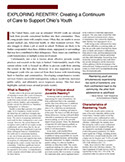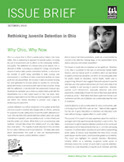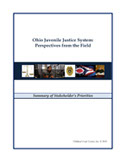Additional Products
For additional products, click here
![]()
For more information about these documents, feel free to contact I.S.P.
![]()
The following resources were developed by or
in collaboration with members of I.S.P. Consulting.
A comprehensive Toolkit on responding to gender-based violence designed for institutions of higher learning. The Toolkit outlines a framework for campuses to help design and adapt their protocols as they respond to allegations of conduct that are proscribed by Title IX and Clery. The Toolkit is designed for multi-disciplinary responders as they work together to find ways to create fair, equitable, and trauma-informed responses.
This paper, a resource for tribes and villages on how to create meaningful responses to abuse in later life, identifies specific guiding philosophies, cultural considerations, and potential action steps tribes and villages might wish to do when addressing abuse in later life in their communities. The back of the paper also includes a number of tools to enhance conversation and planning such as: sample stories; tips for holding a listening session; scenarios for community and system consideration; scenarios for thinking about elder abuse and elder protection; areas of inquiry; a questionnaire for collecting input; and the Abuse in Later Life Power and Control Wheel.
Designing Supervised Visitation and Exchange Centers That Promote Safety
For families that have experienced domestic violence, the exchange of children present opportunities for the parent that has used violence to continue to inflict physical or psychological harm on their children and former partner. Unfortunately, across the country countless incidents exist of battering continuing during visits and exchanges. To promote adult victim and child safety in situations where there is domestic violence, dating violence, sexual assault, child abuse, or stalking, Congress authorized the pilot of the Safe Havens: Supervised Visitation and Safe Exchange Grant Program (Supervised Visitation Program) through the reauthorization of the Violence Against Women Act in 2000.
Navigating the Family Violence Prevention and Services Program: A Guide for State Administrators
On behalf of the Family and Youth Services Bureau, Administration for Children and Families, U.S. Department of Health and Human Services, this guide is dedicated to victims of domestic violence who on a daily basis manage complex decisions to assist in their safety and the safety of their children, and all those who work on their behalf. The guide is intended to be a living document, meaning that it will change over time as information about the FVPSA state grant program is updated and as administrators continue to share their experiences in the form of stories and documents. The guide has several components, including: the main document that contains general information about the FVPSA grant program along with tips and video clips of administrators sharing lessons learned; a glossary with acronyms and terms that an administrator might encounter in his/her job; a large appendix containing a collection of downloadable sample forms and documents; and a resource section that lists national organizations that specialize in FVPSA-related topics and articles on pertinent administrator duties and substantive areas.
Stop Solitary for Ohio's Youth Campaign
I.S.P. designed a campaign to end the use of room seclusion for children in Ohio's out-of-home placements. Campaign included petition, fact sheets, and social media outreach.

Raising Voices for Change: Summary of Survivor Discussion Groups
In 2012, as part of its commitment to include the voices of survivors in guiding its work, OAESV held a series of discussion groups for individuals who have been victims of sexual violence. The discussion groups were an opportunity to learn from women and men about their experiences and document their recommendations for improving community and system responses to survivors of sexual violence.
It is well documented that when there is a history of domestic violence the violence often does not end because the parties have separated or ended their relationship. Instead, the tactics used to exert control over a victim shift; this is especially true when the adult victim and batterer have children in common. When there is a history of domestic violence, visitation or parenting time can be an opportunity for the perpetrator of violence to continue to inflict physical or psychological harm on their children and former partner. To promote adult victim and child safety in situations where there is domestic violence, dating violence, sexual assault, child abuse or stalking, the Violence Against Women Act authorized the creation and implementation of the Safe Havens: Supervised Visitation and Safe Exchange Grant Program (Supervised Visitation Program). The Department of Justice, Office on Violence Against Women, began administering the Supervised Visitation Program in 2002.
Supervised visitation and exchange services for families who have experienced intimate partner violence is a needed resource for tribal communities. This report highlights recommendations stemming from discussion groups held with Native American professionals and consumers about how these services can be created in a way that both meets the needs of families and is valued by the community. Some of the topics explored include the significance of kinship, jurisdictional complexities, impact of poverty and oppression, confidentiality, and other cultural considerations.
On The Right Path: Moving Toward a Safe, Sound and Cost Effective Juvenile Justice System in Ohio
This bulletin highlights of the state of the current juvenile justice system and advocates for the use of cost-effective, evidence-based, and safe practices.
Helping Courts With the Co-Occurrence of Domestic Violence and Child Abuse
Protecting families where there is co-occurring child abuse and domestic violence poses a real challenge to courts and social services systems. A new publication, Helping St. Louis County Families: A Guide for Court Professionals on the Co-occurrence of Domestic Violence and Child Abuse/Neglect, provides practical information to court professionals on the overlap of domestic violence and child abuse to help shape their practice to handle these cases more effectively. The guide was developed as an outgrowth of the 1999 Greenbook, published by the National Council of Juvenile and Family Court Judges, which provided guidance to State courts on the development of best practices. St. Louis County, MO, was one of six communities selected by the U.S. Departments of Justice and Health and Human Services to serve as a demonstration site in implementing the principles of the Greenbook. The current guide provides information on the context for domestic violence and such specific issues as confidentiality, safety planning, protection orders, visitation, family support meetings, personal bias, and vicarious trauma. It was written by Lauren J. Litton and is intended for attorneys, judges, social services providers, and volunteers working with families in co-occurrence cases.
Building an Anti-Sexual Violence Coalition in Ohio ~ Stakeholder Survey Summary
This Report summarizes the findings and themes that emerged from a statewide information gathering effort designed to assist the newly formed Ohio Alliance to End Sexual Violence in its development of a coalition that would be responsive to the needs of its stakeholders.
Online Radio Show:
Putting a Face on Every Child: Ohio's Juvenile Justice Reforms
(May 2010)
Ohio, like many other states, mirrored its juvenile system on the adult criminal justice system. Mandatory sentencing laws accompanied that decision, obligating judges to give out fixed sentences without regard to the crime involved, safety risks, or the youth’s capacities. The short video highlights how mandatory get-tough-on crime laws continue to fail Ohio’s youth resulting in low and moderate risk kids being incarcerated for lengthy sentences in large, warehouse-like facilities that are far from home and not resourced to respond to individual needs. As a result, many of these kids come out of the system years later more dangerous than when they entered. Children’s Law Center, Inc. was fortunate enough to have incarcerated youth, family members, and professionals working in the system share their stories. The DVD is one of two that will be produced on reform efforts in Ohio to help highlight current issues facing Ohioans and opportunities to enhance responses for youth, families and communities. This video spotlights the need for greater judicial discretion and cost-effective sentencing options that foster rehabilitation, by building a continuum of care based upon evidence-based practices that emphasize keeping youth in their communities, in the least restrictive setting possible, with the highest level of intervention, supervision, and services.
I'm Coming Home
(November 2015)
I.S.P. Co-Producer and Co-Editor
The documentary features four Ohio youth – Drew, Lance, Allen and MJ – sharing their experiences in trying to reintegrate back into their neighborhoods and families. Being removed from one’s community, even for a short time, can create challenges for youth as they return to school, try to find employment, treatment, and housing, and reconnect with families and friends. There is stigma associated with juvenile court involvement and for formerly incarcerated youth, apprehension about the risks that formerly incarcerated youth may present to the community. Ohio has led the way in juvenile justice reform by investing in evidence-based programs that help keep kids in their communities and out of systems. It is now time to examine what we are doing to support these youth who return to reduce the risk of further system involvement. I’m Coming Home highlights these struggles and calls for the community to work collectively to help them achieve success and support these kids in their evolution to adulthood.![]()
I.S.P. Consulting was highly responsive and fulfilled our needs in a timely and professional manner. The reports and analysis provided us with insights into how to improve legal services for battered women and their children.
Amber Ptak
Greenbook Project Manager, TESSA
Juvenile Justice Related Fact Sheets and Briefs:
Exploring Reentry: Creating a Continuum of Care to Support Ohio's Youth
Rethinking Juvenile Detention in Ohio Issue Brief
Ohio Juvenile Justice System: Perspectives from the Field - Summary of Stakeholder’s Priorities
Adolescent Brain Development & Juvenile Justice
ISPconsults.com © 2017 | Privacy Policy | Terms Of Use






